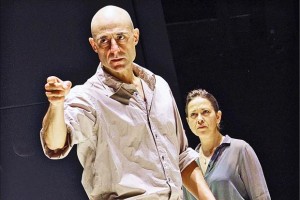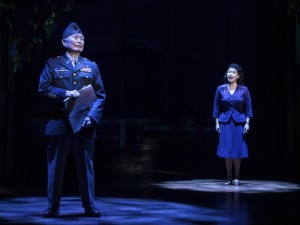In today’s Wall Street Journal I review two Broadway shows, the New York transfer of Ivo van Hove’s London revival of Arthur Miller’s A View from the Bridge and the New York premiere of Allegiance. Here’s an excerpt.
* * *
Ivo van Hove, whose high-concept 2010 off-Broadway staging of “The Little Foxes” was the most pretentious revival of an American classic I’ve ever seen, is upping the ante by directing two Arthur Miller plays on Broadway this season. Judging by Lincoln Center Theater’s transfer of the Young Vic’s London production of “A View from the Bridge,” I shudder to think what damage he’ll do to “The Crucible.”
 “A View from the Bridge” was last seen on Broadway five years ago in a tautly understated production directed by Gregory Mosher that came as close to perfection as a revival can get. Mr. van Hove, by contrast, has opted for the same ostentatious minimalism that he inflicted on “The Little Foxes,” setting Miller’s 1956 drama of incestuous love on the Brooklyn waterfront beneath a giant charcoal-gray cube that hovers over a playing area denuded of props and set pieces. The actors walk around barefoot for no apparent reason, accompanied by snippets of the Fauré Requiem that are played on an endless loop, with a drum tapping at maddeningly metronomic intervals to signify…what? Only, it seems, that Mr. van Hove is so determined to put his personal stamp on “A View from the Bridge” that he doesn’t seem to care whether any of his over-familiar avant-garde tricks are organically related to the script. Instead, they’re poured over it like a rancid sauce.
“A View from the Bridge” was last seen on Broadway five years ago in a tautly understated production directed by Gregory Mosher that came as close to perfection as a revival can get. Mr. van Hove, by contrast, has opted for the same ostentatious minimalism that he inflicted on “The Little Foxes,” setting Miller’s 1956 drama of incestuous love on the Brooklyn waterfront beneath a giant charcoal-gray cube that hovers over a playing area denuded of props and set pieces. The actors walk around barefoot for no apparent reason, accompanied by snippets of the Fauré Requiem that are played on an endless loop, with a drum tapping at maddeningly metronomic intervals to signify…what? Only, it seems, that Mr. van Hove is so determined to put his personal stamp on “A View from the Bridge” that he doesn’t seem to care whether any of his over-familiar avant-garde tricks are organically related to the script. Instead, they’re poured over it like a rancid sauce.
What I find most puzzling about Mr. van Hove’s method is that when you scrape away the sauce of self-regard, what you find underneath, here as in “The Little Foxes” before it, is a staging that gets to the point of Miller’s play with near-naturalistic directness….
 The forced internment between 1942 and 1946 of well over 100,000 Japanese-Americans, most of them patriotic U.S. citizens, is now generally seen as a dark blot on this country’s history. It’s also the stuff of sky-high drama, yet next to nothing in the way of noteworthy art has been made out of it. For that reason alone, “Allegiance,” the fictionalized story of a California family that is relocated to a Wyoming camp in 1942, is of obvious interest. It is, however, of no artistic value whatsoever, save as an object lesson in how to write a really bad Broadway musical.
The forced internment between 1942 and 1946 of well over 100,000 Japanese-Americans, most of them patriotic U.S. citizens, is now generally seen as a dark blot on this country’s history. It’s also the stuff of sky-high drama, yet next to nothing in the way of noteworthy art has been made out of it. For that reason alone, “Allegiance,” the fictionalized story of a California family that is relocated to a Wyoming camp in 1942, is of obvious interest. It is, however, of no artistic value whatsoever, save as an object lesson in how to write a really bad Broadway musical.
Inspired by the experiences of George Takei, who played Sulu in “Star Trek,” was interned as a child and is one of the stars of the present show, “Allegiance” is peopled with characters made of solid cardboard. The Japanese-Americans are all noble and true, the Caucasians yawping apes save for a bosomy blonde nurse from Nebraska who—stop press!—falls for an internee: “When I stepped into this prison/Who knew what lay ahead?/I thought I’d face the enemy/But I fell in love instead.” Jay Kuo’s songs sound like they were written with a Banal Broadway Ballad App. As for historical balance, don’t make me giggle…
* * *
To read my review of A View from the Bridge, go here.
To read my review of Allegiance, go here.
The trailer for the original Young Vic production of A View from the Bridge:
“Japanese Relocation,” a 1942 propaganda film about the Japanese-American internment camps narrated by Milton Eisenhower and made by the Office of War Information. The music heard under the opening credits is an excerpt from Virgil Thomson’s score for Pare Lorentz’s The Plow That Broke the Plains:
